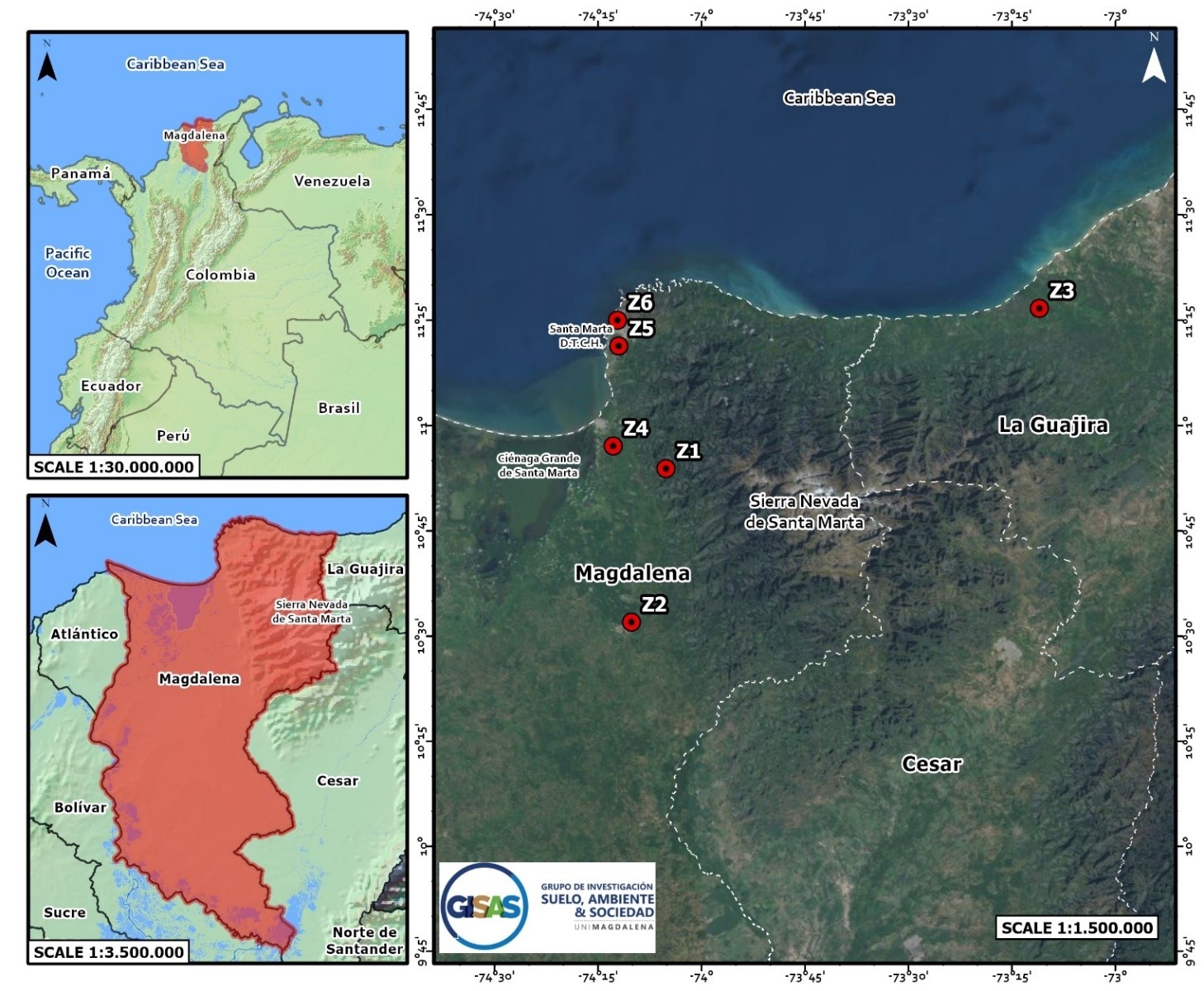Representative soils mineralogy composition from the northern of Magdalena department, Colombia
Main Article Content
Abstract
The mineralogical analyses of soils are necessary to explain the genetics, taxonomic, and physical-chemical characteristics and their critical evaluation to obtain actual and complete knowledge of the resource and its adequate management. In this work, the objective was to identify the mineralogical composition of six subzones in the north of the department of Magdalena, a region adjacent to the Sierra Nevada de Santa Marta Colombia, in a dry climate. The soils of the most important crops in the area and surrounding forests were selected to establish limitations and potentialities. The study was descriptive with the compilation of edaphic and climatic information and mineralogical analysis. The results showed a predominance of dry and very dry warm climates with an average temperature of 27 ºC and an ustic soil regime. The sand mineral fraction is associated with quartz and feldspar content. In contrast, the fine fraction reports Biotite and Haloisite in 100 % of the samples. Zones 2 and 4 also showed Smectite content; in zone 3, Chlorite, and zone 2, a Halite sample (1.3 %) was reported. The analysis of the percentage mineralogical composition confirms that the soils studied present a low evolutionary degree due to the ustic regime that controls the soil development, limiting the alteration of the most labile minerals.
Downloads
Article Details

This work is licensed under a Creative Commons Attribution-NonCommercial-ShareAlike 4.0 International License.
References
Abad, I., y Velilla, N. 2018. ¿De qué está hecho este material? Una introducción al uso e interpretación de las técnicas básicas de caracterización de los minerales. Enseñanza de las Ciencias de la Tierra 26(3): 265-265. Doi. https://raco.cat/index.php/ECT/article/view/343212/434359.
Aguirre, S.E., Piraneque, N.V., y Abaunza, C.F. 2021. Species with agroforestry-systems potential in the Magdalena state, Colombia. Información tecnológica 32(5): 13-28. Doi: https://dx.doi.org/10.4067/S0718-07642021000500013.
Aguirre, S.E., Piraneque, N.V. y Rodríguez, J. 2015. Relationship between the nutritional status of banana plants and black sigatoka severity in the Magdalena region of Colombia. Agronomía Colombiana 33(3):348-355. http://www.scielo.org.co/pdf/agc/v33n3/v33n3a08.pdf.
Besoain, E. 1985. Mineralogía de arcillas de suelos. Instituto Interamericano de Cooperación para la Agricultura (IICA). URL: http://orton.catie.ac.cr/repdoc/A9804e/A9804e.pdf. Consultado: 07 de junio 2022.
Churchman, G.J. y Lowe, D.J. 2012. Alteration, Formation, and Occurrence of Minerals in Soils. En: Huang, P.M., Li, Y. y Sumner, M.E., Editors. Handbook of Soil Science. Properties and Processes. 2nd Edition, CRC Press, Taylor & Francis, Boca Raton.
Delgado, A. y Gómez, J.A. 2016. The Soil. Physical, Chemical and Biological Properties. En: Villalobos, F.J. y Fereres, E. Editores. Principles of Agronomy for Sustainable Agriculture. Springer, Cham.
Gámez-Ramírez. D. 2012. Análisis mineralógico de sedimentos en zonas de playa entre Costa Verde y la bahía de Taganga (departamento del Magdalena). Informe Técnico Final. Santa Marta. Url: https://www.drummondltd.com/estudios-mineralogicos-en-playas-de-santa-marta. Consultado: 07 de junio 2022.
Ghimire B, Ghimire R, VanLeeuwen B, y Mesbah A. 2017. Cover crop residue amount and quality effects on soil organic carbon mineralization. Sustainability 9:2316. Doi: https://doi.org/10.3390/su9122316.
Hernández, M. 1996. Geología de las Planchas 11 Santa Marta y 18 Ciénaga. Ministerio de Minas y energía, Bucaramanga Colombia. URL: https://recordcenter.sgc.gov.co/B4/13010010024387/Documento/pdf/0101243871102000.pdf. Consultado: 07 de junio 2022.
Instituto Geográfico Agustín Codazzi (IGAC). 2009. Estudio General de suelos y zonificación de Tierras. Departamento del Magdalena, escala 1:100000. Bogotá D.C.
Imbellone, P.A., Beilinson, E. y Aguilera, E.Y. 2016. Micromorfología de suelos. En: Pereira, F. y Torres, M. Editores. Suelos y Geología Argentina: Una visión integradora desde diferentes campos disciplinarios. Asociación geológica argentina. Avellaneda, Argentina. UNDAV Ediciones, Universidad Nacional de Avellaneda, Buenos Aires.
Kome, G., Enang, R., Tabi, F. y Yerima, B. 2019. Influence of Clay Minerals on Some Soil Fertility Attributes: A Review. Open Journal of Soil Science 9: 155-188. Doi: https://dx.doi.org/10.4236/ojss.2019.99010.
Malagón, D. 2003. Ensayo sobre tipología de suelos colombianos-énfasis en génesis y aspectos ambientales. Revista Academia Colombiana de Ciencias 27(104): 319-341.
Malagón Castro, D. y Marino Santana, L. 1997. Los suelos de la región del Caribe colombiano. Revista Suelos Ecuatoriales 27: 15-25.
Mercado, M.M., Peralta, F.L., Pons, M.J., Franchini, M.B., Impiccini, A. y Rainoldi, A.L. 2021. Análisis geoquímico y caracterización mineralógica de la alteración y mineralización en secciones de los depósitos Loma de la Plata y Valle Esperanza, distrito Navidad, Chubut, Argentina. Revista De La Asociación Geológica Argentina 78(4):512-538.
Pelayo, M., Villar, M. V., Fernández, A. M., y Pérez del Villar, L. 2021. Estudio mineralógico, geoquímico, fisico-mecánico y de las aguas intersticiales de muestras procedentes de los yacimientos bentónicos de Morrón de Mateo, Pozo Usero, El Toril, San José y El Corralete. CIEMAT. Url: http://documenta.ciemat.es/bitstream/123456789/955/1/BARRAYAC2.pdf. Consultado: 07 de junio 2022.
Piraneque, N., Aguirre, S. y Reis, A. 2018. Carbon sequestration in a Typic Ustipsamment under semiarid conditions. Spanish Journal of Soil Science 8(3): 293-305. https://doi.org/10.3232/SJSS.2018.V8.N3.01.
Soil Survey Staff. 2014. Keys to Soil Taxonomy, 12th ed. USDA-Natural Resources Conservation Service, Washington D.C.
Torres, R.L., García-Casco, A. y Molina, J. 2004. Petrología metamórfica, asistente de prácticas. Departamento de Mineralogía y Petrografía Universidad de Granada. URL: https://www.ugr.es/~petgquim/descargas/CPM.pdf. Consultado: 07 de junio de 2022.
Vásquez, J. R. 2014. Contenido, formas y mecanismos de estabilidad del carbono orgánico en suelos del departamento del Magdalena (Colombia), bajo diferentes tipos de usos del suelo. Tesis doctoral Universidad Santiago de Compostela, España.
Wilson, M. J. 2019. The importance of parent material in soil classification: A review in a historical context. Catena 182: 104131. Doi: https://doi.org/10.1016/j.catena.2019.104131.
WRB. World Reference Base for Soil Resources. 2014 update 2015. International soil classification system for naming soils and creating legends for soil maps. World Soil Resources Reports No. 106. FAO, Rome.

